#which is primarily a static camera shot of her speaking
Text
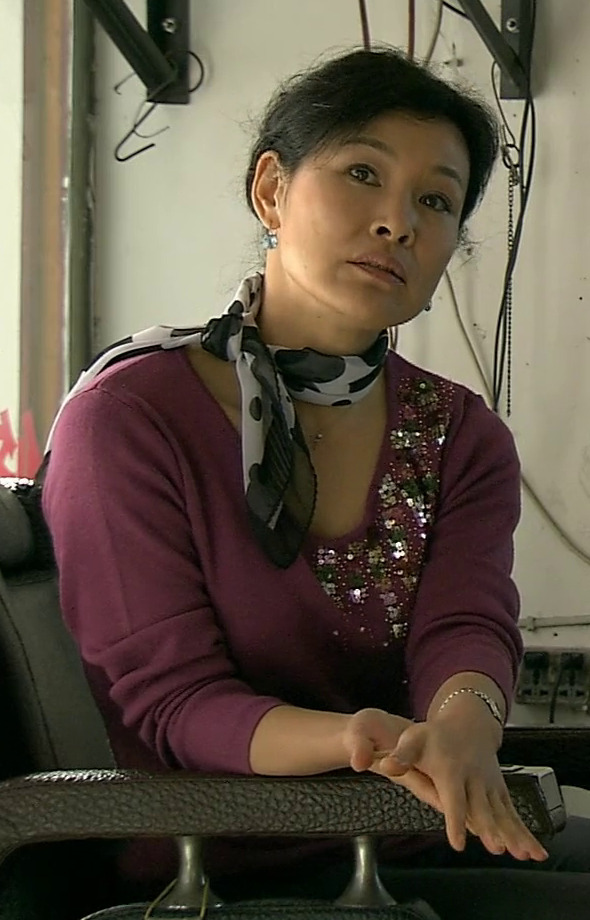

as a general guide, reference(?) for how ada ages, her face beneath the crow beaked mask she wears during her time in the village, here's her faceclaim (joan chen) in the movie 24 city, which was released & filmed around 2008, when she would've been 47, the same as ada during the events of resident evil: village . another visual reference, though obviously not a faceclaim, is kim seo hyung in mine (2021) .
#* file // : OOC — ( 𝐓𝐇𝐄 𝐏𝐎𝐒𝐓𝐄𝐑'𝐒 𝐂𝐑𝐔𝐒𝐀𝐃𝐄 . )#i guess it does help that joan chen has basically barely aged since twin peaks#just look at her photoshoots with WSJ China#this movie is filmed as an interview with various residents of chengu & she's there for only one segment#which is primarily a static camera shot of her speaking#so i'll scout around for other films she's in released around 2008 as 24 city was the easiest to track down
9 notes
·
View notes
Text
So, I’m putting all my crack theories/observations about hnk in one place so that if any of them are proven correct I’ll be able to refer back to this and say that I called it.
The title of Ichikawa’s art book, Pseudomorph of Love seems to allude to her approach for Phosphophyllite’s changes. Whenever Phos loses and gains a new body part, it’s an act of compassion in some way. Except for the pearl eye, all of Phos’s alterations have followed this pattern
They lost their legs while trying to help Ventricosus, and gained their agate legs because Ventri decided to show them compassion and not stoop to the level of the Lunarians.
While Phos’s own self-hatred tempted them to chop off their arms, it was only when the ice floes preyed on their desire to save Cinnabar that Phos accidentally-on-purpose lost their arms. Antarc initially dismisses the gold and platinum as useless, but when they see that Phos is not-so-subtly projecting their own feelings of uselessness onto the metals, Antarc changes their tune and decides to attach them to Phos. In a roundabout way, Antarc is trying to communicate to Phos that they aren’t useless ;_;
Phos loses their head trying to save Cairngorm’s arm, and Cairngorm decides to give them Lapis’s head. While they kind of can’t help but project Lapis onto Phos after they wake up, the fact that they were willing to give up their own head, and the fact that they finally admitted to themselves that they don’t believe any of the gems will be brought back indicate to me that they did this out of genuine concern for Phos and not because they’re trying to resurrect Lapis.
Edit as of 5/11: I totally forgot about this, but Phos loses Lapis’s hair trying to shield baby Morga and Goshe from the lunarians.
Edit as of 6/12: Phos had to have some pieces chipped off from trying to help Cinnabar. They also lost the piece of their leg they offered to Variegatus.
Because the pearl eye is the exception to this, and is primarily associated with betrayal on Phos’s part and manipulation on Aechmea’s, I suspect it’s going to be replaced later on in the story, maybe by a red pearl, which is closer to how the pearl is described in the whole seven treasures thing. (and just as an aside, I totally buy that Ichikawa is referencing the seven treasures with Phos’s new limbs. She said in an interview that Buddhist sutras about gemstones are what inspired her to write the story in the first place so I think it’s safe to say that she’s familiar with the concept.) I also think that Phos will get this possible new eye from Cicada, because he is a cinnamon roll.
I also think that Phos choosing to get rid of one of their alterations and replacing it with a more positive one would be a good way to progress their character arc while also forwarding the work’s themes about identity. Perhaps the solution to the tragedy of Phos slowly losing themselves is gaining the capacity to choose how they change, which I find a lot more poignant than edgy pondering about how Phos isn’t Phos anymore–I find that take in particular to be a rather un-nuanced appraisal of Phos’s situation, and it bugs me how common it is.
I think that the lower half of Phos’s torso is going to be the next thing to go, leaving only their chest (metaphorically, their heart) behind. There are several bits of visual story telling that lead me to think this is a possibility. The first is in the various non-permanent injuries that Phos suffers throughout the series. I may be reading too much into things since there are only so many ways for Phos to break, but it’s possible they function as visual foreshadowing:
loses their arms and legs in the first chapter after getting caught up in Kongo’s attack
loses their arms while trying to grab cinnabar
is completely dissolved by Ventricosus (I’ll come back to this.)
left eye gets knocked off by one of Aculeatus’s tentacles
arms get shattered after Kongo yells at them
an arm gets broken after Phos falls off the roof of the school
they get cut in half by a lunarian’s arrow
their face is punched off twice by Cairngorm
they destroy their head during a mental breakdown, and then get punched in half by Jade–in more or less the same spot where they got shot before
lol I cannot keep track of all the injuries they got against the explosive shogi pieces
Cairngorm shatters their torso
Aechmea slices off their limbs
Every single one of Phos’s more permanent losses has been preceded by at least one injury to the exact same area. In the first half of the manga, it was mostly losses of their arms and legs, in the second half, we see a lot of Phos getting either decapitated or bisected.
Another bit of visual storytelling comes from the anime. The director has stated in an interview that he had a long chat with Ichikawa and is aware of future events not yet depicted in the manga. While he obviously wasn’t allowed to overtly hint at said future events, there’s one bit of anime-original content that might hint at Phos’s future changes. The abstract scene of Phos being put back together after being dug out of the shell is very different between the anime and manga. In the manga, they slowly coalesce out of a stream of Cinnabar’s mercury. In the anime, Phos forms out of a liquid of their own coloration. What I want to focus on is what the camera emphasizes in this scene. It focuses on Phos’s feet, arms, pelvis, head, and then their eye. Apart from their pelvis, these are all parts that Phos eventually loses. I suspect this scene was actually the director trying to include some visual foreshadowing.
Assuming I’m right about Phos losing half their torso, I think Padparadscha is going to be what replaces it. Despite their few appearances, they’ve been given a lot of narrative weight, and have a similar coloration to carnelian, ruby, and amber–which are the different interpretations of the red gem written of in the aforementioned sutra. Not to mention all the lotus symbolism surrounding them.
I think that the new Morga and Goshe are actually reincarnations of the old ones, only they were reincarnated as the others’ gemstone. New Goshe’s personality matches old Morga’s and vice versa. The fact that they heard Phos calling out to them in their dreams while Phos was dreaming of the shattered gems seems like a dead giveaway to me. Although given how bad the translation is, I could be misinterpreting Goshe’s words. That said, I do think that Phos is actually somehow psychically connecting to the dead gems in this scene and not just dreaming–the fact that it’s the first full-color scene we’ve had since the beginning of the manga just screams “Pay attention, this is important!”
I’m not the one who came up with this theory but I certainly agree with it: I think that the reason the gems were ground into a fine powder and not just turned into jewelry is because it allowed the Lunarians to extract the gems’ inclusions, and that’s what the human particle is made of. In which case, the dusted gems are well and truly dead, and no amount of reconstruction will bring them back. In my view, the thematic core of the story is about coming to terms with change, loss, and death. Bringing back the lost gems would undercut this theme.
However, I have a feeling that Antarc was actually kept alive. This is one of my crackier theories but please bear with me:
As much as I love Phos to bits, Antarc would probably hate the person Phos has become, which means Ichikawa could still forward those themes I just mentioned even if Antarc was brought back. Things would never be the same between them.
The fact that Aechmea had a replica of one of the broken pieces of Antarc’s face ready when he met Phos is reeeaaaallllly suspect. At the very least, it means that Aechmea has been interested in Phos and has expected them to come to the moon eventually for a while now. Why on earth would he just happen to have a piece of Antarc on him otherwise? My theory is that when Aechmea became aware of Phos’s new arms and the fact that one of the seemingly static gems was rapidly changing, he took an interest in Phos and decided to spare Antarc so he could use them as leverage. (Not that he really needed to since Phos was dumb enough to do his job for him and bring a bunch of potential hostages to the moon. rip)
Going back to the situation with Morga and Goshe, I think it’s possible something went wrong when the Lunarians tried to extract their inclusions which lead to their inclusions dying, and thus why Mora and Goshe were reincarnated whereas none of the other gems appeared to be.
Also going back to when Phos got dissolved and eaten, I think it might be foreshadowing that by the end of the story, Phos will have lost all their original parts. Or maybe it’s just supposed to clue us in early on that the story we’re reading will be about how Phos is broken and repaired, both literally and metaphorically. One or the other…
I’ve noticed that apart from Phos (and kind-of-sort-of Cinnabar,) no one appears on the volume covers more than once. Since they’ve been pretty active recently, I suspect that Euclase and Jade will be on the cover of volume nine. On a related note, I think that Cinnabar will finally crawl out of their dust jacket hovel and onto the cover in the final volume.
The Lunarians briefly mention a gem called Apophyllite after they collect Phos. The fact that there used to be a gem who was the same color as Phos, as well as having a name with similar etymology–and said etymology refers to both gems’ breakage no less–makes me think they might be important later. It wouldn’t be the first time Ichikawa casually name-dropped someone crucial to the plot many chapters before they became relevant.
While Kongo couldn’t understand Ventricosus, the way he talked about the ice flows made it sound like he could understand them. So I think the ice flows must be speaking some human language.
The Admirabilis all seem to be named after the shapes of their shell. Aculeatus means spiked, and he has a spiky shell. Ventricosus means swollen or distended, which may refer to her round snail-like shell. Variegatus means multicolored, so if we ever see her shell, I expect it will be very colorful. I also think Variegatus herself might be bluish green like Phos, since the chapter focused on her definitely invited parallels between her and the old Phos, what with her outgoing personality, the fact that her people see her as a little kid and don’t take her seriously, her tendency to get herself in trouble, and her desire to venture past the safe confines of her society and explore the gems’ island and the moon. Not to mention the fact that Phos themselves could be described as variegated at this point in the story.
Melon has pikachu powers as a sort of fantasy take on tourmaline’s pyroelectric (generates a charge when heated) and piezoelectric (generates a charge under applied mechanical stress) properties. But hemimorphite is also strongly piezo/pyroelectric. I theorize that the reason the two were paired up was so that Hemimor could teach Melon about their electricity powers, and that we’ll see Hemimor using said powers sometime in the future.
Everyone’s already talking about that intriguing shot of the human particle after Phos gets the pearl eye, so I don’t really have much to add to that discussion.
Also, I’ve seen people speculate that the gems are all super short because of how tall they are compared to Kongo. I don’t know if I buy this though, because that assumes that Kongo is as tall as an average human man, which has never been confirmed. When we see Aechmea stand next to Phos, he’s not much taller than they are. In any case, I think it’s a bit too early to speculate on how tall the gems are.
Well that’s about all I can vomit out of my brain for the moment. And despite the wall of text I just wrote, I don’t have much of an idea of how the story will end. I’m excited to see what Ichikawa will say with the ending regardless of how happy or sad the story ends up being. Knowing her, it’ll at least be interesting.
198 notes
·
View notes
Text
Review 2: Tokyo Story
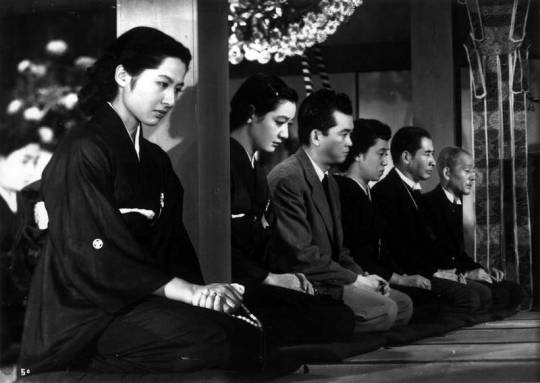
Yasujiro Ozu's 1953 film, Tokyo Story, follows three generations as they go through life yet focuses on the generation soon to leave it, taking the viewers along for this external and internal journey. This review will focus on the parents' journey, the film's slow pacing and Ozu's distinctive cinematography style to give viewers an original yet complex experience.
The film is about an elderly couple, Shukichi and Tomi, visiting their grown children in Tokyo. They stay for a few days but quickly discover that their children have grown apart from them and appear to be bothered by their parents' presence.
The film is less about Shukichi and Tomi's literal journey from their hometown Onomichi towards Tokyo and more about the figurative journey of how relationships between parents and children change over time, how it affects parents, and how one must come to accept these changes. Children will ultimately grow apart from their parents and have less time to spend with them. Koichi and Shige are oblivious that the true purpose of their parents' visit is to spend time together and improve family relationships. Shige welcomes her parents with cheap crackers and less food than her brother had planned. The film also addresses the parents' dissatisfaction with their children. They gradually reveal that they recall their children being kinder. An intoxicated Shukichi complains with two old friends that Tokyo is overcrowded and does not provide enough opportunities for its citizens. In this way, he looks for justifications for his children's lack of affection. As a result, their internal journey throughout the film changes their perspectives of their children from disappointment to understanding.
The pacing of Tokyo Story is slow, which draws the viewer's attention away from the outcomes of the narrative and toward the journey of reaching those outcomes. The incidents are slight, and there is no apparent change in characterisation or mood. Important events are often not shown on screen but revealed through dialogue, as the train journeys to and from Tokyo are not depicted but discussed upon arrival. As a result, the film is intensely engaging. Ozu's steady, clear-eyed gaze heightens the viewer's attention to detail. At bedtime, the mother's gradual lowering of herself onto her tatami mat expresses her dissatisfaction with her children.
Ozu's distinctive cinematography style includes low camera angles, primarily static shots, and deviations from Hollywood filmmaking principles such as master shots and the 180-degree rule. The low camera angles suggest that viewers watch the scenes while sitting on a traditional Japanese tatami mat, focusing only on what is directly before them. Ozu seldom used master shots and often deviated from the 180-degree rule. Characters that frequently sit next to each other appear to be facing the same direction while speaking, like in the opening scene with Shkichi and Tomi. At first, they face right; however, they face left when the sequence ends.
The internal journey the parents go on with the help of the film's slow pacing adds to the film's complexity. The slow pacing engages viewers' interests by emphasising the parents' journey of understanding that their children have their own lives to focus on. Consequently, the journey is further emphasised by the originality of Ozu's cinematography style, which deviates from the familiar conventions used in film. As a result, Tokyo Story is highly recommended for viewers' who want to experience the final journey each parent must take while seeing the beauty of Ozu's work.
0 notes
Text
#5 Mock-Ups of work
Finding interesting ways to create mock-ups of my work was challenging. My industry and personal interest does not lie within static mediums such as, photography, design or illustration. I curated a number of solutions to this issue in creative ways so that I can still showcase my abilities when working with primarily video and motion graphics.
Animated logo
One idea I had was to simply animate my logo. This would, not only showcase my ability at using Adobe After Effects CC, it would be a useful piece of video that I could import into future projects to make my brand stand out a little more boldly compared to a static logo.
I decided to create a simple 3D spin to my logo. Due to my limited resources working from home, due to Covid and a recent hack on the University systems, I did not have access to Cinema4D, so I had to get creative to work with the 3rd dimension.
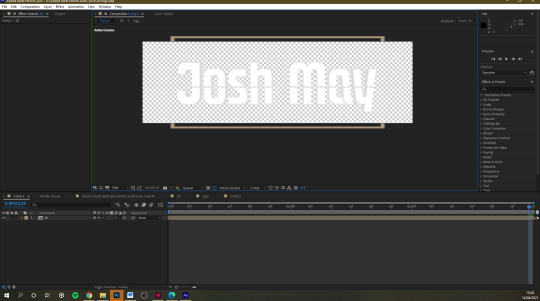
I started by inserting my vectorised logo into After Effects and adjusted the composition to 3 seconds long in its settings. I created 2 compositions from the logo. One was named "3D" and the other "Logo". Logo is simply the logo 3D is where I will be working to create the effect.
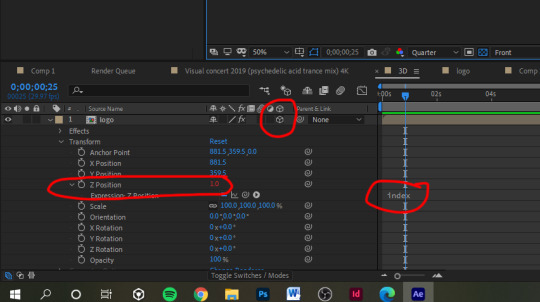
Within the 3D composition I enabled access to the Z-axis position by pressing the small 3d cube circled in red. From there I was able to link the position to the index, meaning that if there is another layer that currently holds any of the space this logo is positioned on then the Z-axis coordinate pushes this layer forwards 1 pixel. Once I had done that I could duplicate this composition to adjust the thickness to my liking.
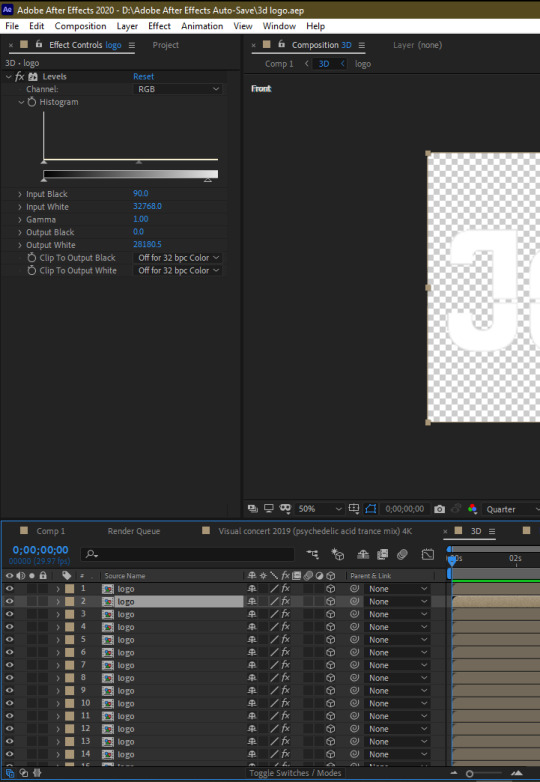
Additionally to this I added the "levels" effect to all of the layers to make them a darker shade of grey. I then removed the effect from the top and bottom layers so that it would create a more clear 3D effect when viewed from the side.
This image shows the object from a different angle to demonstrate the effect:
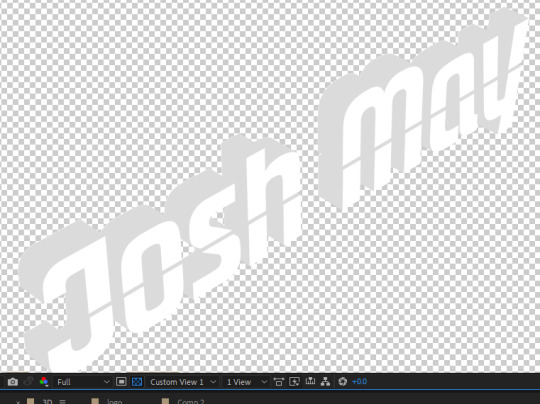
Having done that I was finished adjusting the 3D composition as the 3D effect had been established. Next I returned to the main composition and added a -1x revolution of the Y-Axis keyframe at 3 seconds so that the animation can loop endlessly.
I find that the simple spin looks really effective with the small cut my logo has through the middle. It helps to emphasise the 3D nature of the logo.
I am happy with the outcome considering my lack of resources. I found that trying to use colours, imagery and different transitions took away from my minimalist look. This is simple and applicable anywhere necessary.
Once I had done this I simply exported it.
Unfortunately, my laptop does not have the ability to play .MOV files so I was unable to export in RGB+Alpha. This would give me the ability to export it with a transparent background, enabling me to have this animation on my website without the annoying black box around it.
60 Seconds Profile/Showreel
Another idea was to create a short Showreel of my previous work. This is a quick and effective way to show my personality and ability to produce high quality video content to anyone interested.

Here is a "Me in a minute" Showreel from a Deb Shien. She is a graphic designer from Los Angeles. Having watched this Showreel video a number of times, I was inspired by some of the design choices it features. The first example is the minimalist look. Many of the shots within this video are simply black screen with a couple of clear and bold words over it. It removes distractions and gets the viewer reading every word. The whole video features less than 50 words yet you gain a full understanding of what she does and her motivations for doing so.
Additionally, she picked a fairly midrange tempo song of around 110-120bpm. This enabled her to align each element of the video with the beat of the song without them coming and going too quickly for the viewer to see. This creates a nice sense of pacing to the video and also demonstrates her video editing ability.
Finally, she simply ends the video with an empty screen that only has her website address on it. It is a simple yet effective way to finish the video as it may encourage the viewer to visit her website to have a more in depth look at what she does.
https://www.youtube.com/watch?v=BkPejUiL7TY
I took additional inspiration from The New Apple iPhone SE advert. This is relevant as although Apple are selling a product, I essentially am trying to sell myself.
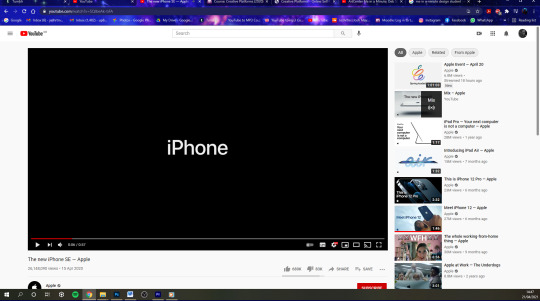
Although I am an avid Android user, as of 2018, I must appreciate Apple's ability to market themselves and their products. Similar to my other research and my own self branding, their minimalist look helps to keep their content consistent and effective. This straight forward technique allows Apple to educate the viewer of what the product is capable of quickly and without confusion.
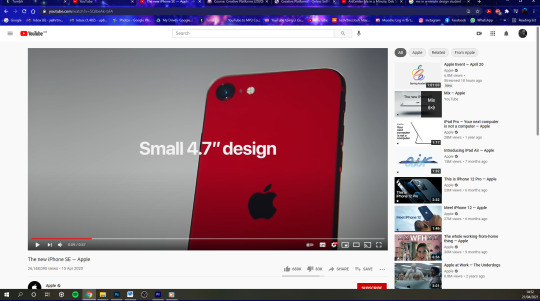
The high quality close ups, animations and interesting visual effects help to make the advert gripping and memorable. This is also complimented by the text on screen exclusively being important new design features.
https://www.youtube.com/watch?v=SQIbeAk-bFA
My Showreel:
youtube
As you can see from my Showreel, I took much inspiration from my research. Quick cuts in time to the beat, up tempo music and good pacing throughout helped to create an effective piece of self advertisement.
Every piece of footage, animation and screenshot within the video is all purely relevant work I wished to demonstrate to anyone potentially interested in me.
I found the slightly corny nature of the video helps to show my less serious and more creative and interesting nature when compared to others I researched which were purely just the individual speaking to them camera for 60 seconds.
An example of this can be found here. This method is a far more academic way of self promotion. They are selling themselves, I am focusing more on my work with a portrayal of personality.
0 notes
Text
Berlinale Film Festival 2021, Industry Event, Day 2
One of the great treats of going to a film festival is getting the chance to wake up and see some transgressive mindfuckery first thing in the morning. This can be either thrilling, like seeing ANTICHRIST at 10:00 AM in Toronto and then being excited to see if the rest of the day’s movies can top that; or it can knock you out for the rest of the day, like seeing IRRADIATED at last year’s Berlinale and needing to process my contempt and hope for humanity.
Of course, part of the thrill of these experiences has been sitting with an audience and going through the mindfuckery as a collective, feeling the energy, seeing people walk out, getting through it together. When things are moved online, and the timing and schedule of your streaming film festival is more or less up to you, many pleasures are lost. But I have to say, there was a thrill in getting up at sunrise to put on some headphones and sit with THE SCARY OF SIXTY-FIRST, an effectively wild and perverse shriek of a movie from first-time director Dasha Nekrasova, and part of this year’s Encounters section.
Shot in New York City, on beautiful 16mm film, THE SCARY is a steep plummet down the conspiracy theory rabbit hole, triggered by the death of Jeffrey Epstein and two roommates moving into a new apartment on 61st Street that may be linked to the man and the sex trafficking ring he was involved with. These details are merely the place setting for an aggressive and sometimes messy assault on good taste and mainstream cinematic conventions. The two roommates descend into different kinds of madness — Addie seems to be possessed by some sort of evil within the apartment, while Noelle is quickly consumed by the conspiracy theories circling Epstein, the royal family, pizzagate, etc. Wedged between the two is Nekrasova herself, playing an amateur sleuth who indoctrinates Noelle with lurid websites, pharmaceutical speed, and sex. From there, the rabbit hole just keeps getting wider and weirder, Addie becomes obsessed with Prince Andrew and creepy tarot cards keep popping up. There will be blood.
I found it all pretty damn intoxicating, but I can understand that others will be put off by its shrillness and lack of subtlety. While the movie is dedicated to Stanley Kubrick, and it gets some inspiration from EYES WIDE SHUT, it’s more along the lines of John Waters crossed with John Carpenter. If you hated FEMALE TROUBLE, you may want to stay away from THE SCARY OF SIXTY-FIRST. Otherwise, this movie sits comfortably next to the kind of outre indie horror movies that got passed from VCR to VCR in the late 80s and early 90s. But what really makes THE SCARY kick, is how directly it speaks to the age of QAnon, the equal parts seduction and repulsion of violence, and the horror that comes from being trapped in a system you have no control over. My only complaint is that the film leans a little too heavily on old horror tropes right at the end, but this couldn’t take away the thrills it provided up to that point. I’m already looking forward to how Nekrasova might follow-up this one.
This year’s Golden Bear for best film went, deservedly, to Radu Jude’s BAD LUCK BANGING, OR LOONEY PORN. Another extremely transgressive film, this one takes a flamethrower to contemporary values in Romania and any other place where racism, sexism and authoritarian fetishism have taken root — meaning, it’s both very specific to Romania and quite universal.
The movie begins with a very graphic and absurdly funny home porno, being shot on a phone. Soon enough, we find out the woman in the video is Emi, a respected history teacher at a private school in Bucharest. The first act of the movie is Emi walking through Bucharest. The city is littered with signs of capitalism run amok, juxtaposed against fervent religiosity. Gambling and wholesomeness. Tastelessness and righteousness. The camera makes these connections with some choice camera panning maneuvers. These movements bring to mind Robert Altman’s style of movement — casual yet smart and impactful.
As Emi makes her way to her destination, the film’s regard for realism begins to deteriorate. Bit by bit, drivers begin showing less regard for the safety of pedestrians. Everyone is foul-mouthed and inconsiderate of others, even while wearing pandemic masks. If you can’t afford a car, who cares about you? It’s not that far from reality, but the pointed exaggerations start piling up and lead us into the mid-section of the film, where we’re treated to an A-Z montage of our most pressing issues and what’s wrong with the world. It both serves as a rundown of the topics that are going to present themselves in the final act of the movie, as well as more visual evidence of our corrupted values and moral decay. It’s a bitter and bleak hoot.
It’s all leading to a confrontation between Emi and her school’s parent-teacher board. It’s one of the most absurd, insulting and cuttingly insightful trials put on film. What are a teacher’s responsibilities outside the classroom? What if the teacher in this situation were a man? What if the teacher is also including lessons about Romanian history that today’s citizens would rather not deal with? All of this and much more is on the table for riotous discussion. More than once, someone cackles the Woody Woodpecker laugh when the debate really goes off the rails. While the visual language in the final act settles into a more conventional groove, the sound editing is something of a tour de force. It’s punchy, freewheeling, obscenely hilarious and brings the movie to an unbelievable final moment.
BAD LUCK is a hard act to follow. If I’d known how ambitious it was, I would have saved it for day’s final screening. But for better or worse, the next film was a very quiet, understated Competition title — this one from Hungary (which was well-represented this year), entitled NATURAL LIGHT. Written and directed by Nagy Dénes, this is a gorgeously shot war-is-hell movie that follows a weathered unit of Hungarian soldiers as they try to round up Russian partisans during WWII. Yes, the title of the movie perfectly describes the golden, autumnal hue of the movie, as it is primarily set in barren forests, small, sooty villages and fields with plenty of mud.
The film is based on a massive book by novelist Pál Závada, but Dénes made the interesting decision to just focus his movie on a few days in the life of István Semetka, who is forced to step up and take charge of his unit early on in the film. Aside from capturing the unrelenting force of their natural surroundings, cinematographer Tamás Dobos also does an amazing job of capturing people’s faces — not unlike the films of fellow countryman, Bela Tarr. Ferenc Szabó, who plays the beleaguered Semetka, has two of the most soulful eyes I’ve seen on screen lately. This is of critical importance since the film has very little dialog until a couple of well-written monologues at the end. Semetka’s eyes say it all.
As mournfully beautiful as it is, NATURAL LIGHT isn’t an easy movie to sit through. It’s quiet and heartbreaking. But this level of sorrow and atrocities is also very familiar to cinema. In a way, it’s unfair because this story, in its way, is unique. But the message of how indifferent war is to soldiers with good intentions, has been told before. Few movies, however, have told it in such a wordless and poetic way.
Throughout the history of film, there’s always been a struggle to turn good theater into cinematic art. When talkies began and TV took off, we turned to the wealth of good theater scripts that already existed as readymade source material that could meet the demand for content. Sometimes it works, and the scripts can be well-adapted into the cinematic language. Other times, it’s like we’re just looking at a filmed documentation of a theater piece, which relies heavily on the strength of the words and performance, and not on any tools of the filmic trade. Denis Côté’s new film does a neat job of adding a new wrinkle to this long tradition of finding ways to turn monologues and long chunks of dialog between two people into an engaging work of film.
Côté has always had a strong experimental streak to his work, and even though he wrote this script and titled it “Social Hygiene” in 2015, it would seem that the current pandemic gave him the final push to turn the unusual idea of long, socially distant conversations in a field into a movie. Aside from a few shots that follow a young woman as she walks through nature, says hi to some livestock and offers an intermission dance sequence, SOCIAL HYGIENE is a series of static shots, framing different sections of rolling Canadian countryside, and containing a couple of people talking to each other across a certain distance. The framing, the sounds, the tone and rhythms of the conversation, are all very stylized. And in its way, perfectly cinematic. Côté pays attention to the ambient noises during these scenes. Birds turn into a cackling audience, construction noises go quiet and resume at just the right moments — it’s all very well-orchestrated.
The story and conversations of SOCIAL HYGIENE have nothing to do with the pandemic. It’s the fairly universal story of a charismatic, smooth-talking guy of unmet potential, who is consistently disappointing the women in his life. This man is Antonin, and we first meet him as he bickers with his sister. While Antonin is married, he’s currently living in a friend’s car, getting by through small-time theft and avoiding plans that might improve his lot in life, like working on that screenplay he’s been kicking around. Both his wife and his mistress try to prod him in the right direction, but he’s such a charmer that he enjoys spinning his destitution as the life of a lovable rogue, who’s morals and values can’t be met by traditional means.
More than any other film seen, so far, from this year’s Berlinale lineup, SOCIAL HYGIENE had me laughing-out-loud the most. And I’m very willing to admit that this is likely due to how much I related to Antonin’s faulty reasoning. But it’s also due to the fact that the script is supremely sharp and its deadpan delivery brought to mind Hal Hartley’s films. Like Hartley, Côté is anti-realist in his staging and delivery, meticulous in his timing, and yet uses humor to get at some very fundamental human dilemmas. I love Hartley and miss his sensibility dearly. So, yes, I loved every minute of SOCIAL HYGIENE.
Even with a press pass, it can be a challenge to sit for every Competition screening. There are simply too many other films that call for your attention. But in this streaming scenario, I was committed to seeing every last one. I felt like I didn’t have any good excuse not to when you can make your own daily schedule. So, Xavier Beauvois’s ALBATROS (or DRIFT AWAY, as it may end up being called in your neck of the woods) got a late Tuesday night home screening. It didn’t go down well.
The only one of Beauvois’s previous films that I’m familiar with is 2005’s THE YOUNG LIEUTENANT, which follows a homicide detective in La Havre. ALBATROS follows a police chief in the much more idyllic region of Normandy. Jérémie Renier plays the cop, Laurent, and just as the movie starts, he’s just proposed to his girlfriend of ten years, with whom he already has a young daughter. In the next scene he’s cleaning up after a suicide on the beach, and then there’s news of child abuse by local resident, and his friend is at the end of his rope dealing with farming regulations. Things are piling up quickly, and the chipper Laurent is soon getting edgy and taking his work home with him.
The beginning of the movie isn’t bad. It’s clearly building to something and it can hold your interest while it does that. But when that shoe drops, the film goes off the rails and descends into a completely ridiculous and phony final act. It doesn’t help matters that Beauvois never really finds an interesting visual language with which to tell this story. From the get-go, his camera is just there, shooting scenes and conversations in a way that makes everything seem slightly off and unnatural. It feels like things are being staged, much as the wedding photo on the beach that gets interrupted by a death at the very beginning. Unfortunately it never shakes this feeling, and two hours later, you can’t believe that you’re watching an ending so clichéd that Hollywood would probably think twice before giving it a greenlight. It’s the kind of denouement that is so cheesy and unearned that instead of choking back tears, you feel completely cheated.
Aside from ALBATROS, Day Two was a rich abundance. The punk stylings of THE SCARY OF SIXTY-FIRST, the anarchic Molotov cocktail of BAD LUCK BANGING OR LOONEY PORN, the austere meditation of NATURAL LIGHT, the playful theatrics of SOCIAL HYGIENE — these all had something special to offer. Tomorrow, we’ll visit China, France, Georgia and, once again, Hungary, for two more films with big rewards and two that struggled to transcend their formal trappings.
0 notes
Text
Psychiatric Filmmaking 1: UCLA & the Aesthetic-Industrial Dimension
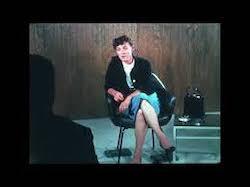
Is there such a thing as a ‘psychiatric cinema’?
There is certainly a psychotic one, but ‘psychotic’ is not an official diagnosis—and even if it was, we know the word through crimson pulpy images and not textbooks. Norman Bates’ shower is more famous than Freud’s Wolf Man; the image of Lon Chaney Jr’s makeup comes to mind whenever Sergei Pankejeff is mentioned—who is usually called the ‘Wolf Man’ and not Sergei Pankejeff. Common parlance leads diagnostic recognition, which also draws from it. And despite its long and strange relationship with the Scientific, psychiatry is primarily an aesthetic study. Freud’s most revolutionary conclusions placed it among the arts, as a continuous working hypothesis dependent on what can never be verified. Films, bestsellers, the fashion world, even military theory and economics are full of the language and romance of psychiatry. The greater the hold of the sciences of the uncertain, the more and more certain the world was forced to become. We remain stable, cautious. Trump is definitely ‘psychotic’. Stalin and Mao were psychotic, too. These three men have a close relationship with the art world.
In the late 1950s and early 1960s, corresponding to the psychiatric boom in modern mass advertising, a modish filmmaking appeared which combined a cramped and stark television-style frame with an interior ‘character’ development moving along the lines of case studies and group informants who acted as both individuals and as psychic types. Who watched these little films? Experts, students, doctors, perhaps certain policy makers or financial intermediaries. The audience is small, insular, so why should the filmmakers be concerned with way the action conveys the evidence? Because there is a certain logic in photographic history which must, like psychiatry and language, ‘make sense’ according to its own properties and its own grammatical rules (editing is also a part of this complex). These interviews must not fall under the spell of their subjective madmen, so they must employ fictional techniques—framing techniques that have seeped into our brains since the first photograph was taken, maybe ever since the Renaissance. And remember that Wiene’s Caligari used a deliberately static camera, an unnerving and obsolete choice by 1920, which, combined with the painted sets, made the film consciously archaic and thus, Modernist.
Our subject here, taken from what we could call an industrial psychiatric trade cinema, comes from a period when ethnography was informed by the already ancient pleasures of Black and White and the ‘reality’ of vibrant color motion picture images. The first film, part of the ‘Psychiatric Interview Series’ franchise, is subtitled ‘Patient No. 1: Evaluation for Diagnosis.’ It was produced for the Department of Psychiatry by the UCLA Motion Picture Division of the Theatre Arts Dept in 1959. It uses two cameras with two standard positions (the establishing moments show the two participants already seating themselves, making the ‘reality’ of the examination a cut into unfilmed time). The initial camera position is over the shoulder of the ‘psychiatrist’ (?), showing the patient at a left angle, medium close. The second position is the patient only, closer medium shot (head, shoulders and chest), in three-quarter profile with a slight shadow. There is no shot-reverse-shot, which maintains the total anonymity of the physician figure, as well as his power. The audience is the third presence, watching it unfold passively. The filmmaking is entirely ‘unreal’, or rather studied documentary, and resembles a sequence from Perry Mason, emphasizing the ‘perp’ before the law, in Black and White. The sound is clear throughout, which might indicate post production clean up or a separate sync recording which was then added onto a strip to the silent film (the sync is badly off, perhaps due to the transfer to video or the youtube uploader; such carelessness seems at odds with the professional lighting and simple but deft use of cinema language used by the UCLA filmmakers).
The unnamed patient is that old city nightmare, the runaway, a graduate from all the major schools in America: reform school, Juvie Hall and jail, as well some actual prison time (under a year). She tells the talking head to her right that she’s had four pregnancies, but relates six (he corrects her, but does not seem to notice that she might be counting twins as a single ordeal, as well as confusing the living and the dead—two stillborn and two deaths right after birth). Car theft, truancy, passing bad checks, traffic violations and dope: all of these are de rigueur in a dirty little city kid, but they indicate an unbridled criminal apprenticeship if one is a servant of middle class morality (that is, if one is a psychiatrist). She speaks of the hallucinations of amphetamines, of the outlines of figures in smoke, while she chain smokes herself, the curls and eddies moving pleasantly at the side of the frame like one of Fu Manchu’s altars or Cagney waiting for his parole officer. There are several good dialogue exchanges, which seem scripted in that uncanny sense which now governs our too educated, suspicious minds:
Her: I was seeing things.
Him: What did you see?
Her: Mostly people.
What else is there to see? But she sees only their shadows (in the sequel, the interviewer has become a flat shadow darker than any shadow, his grey details consumed by pure black to differentiate him from the colorful patient who now sits on the right side of the frame). She is seventeen years old, pleasingly dykey, almost like the singer kd laing, and has had ten to fifteen rounds of shock treatment by her own request. The doctor notes her androgyny by asking her if she looks like her father, especially the hair, which is curly and short and clearly a dead giveaway. Her dad was in army, he comes and goes but her problems, like many daughters, are with her mother. And everyone has called her crazy since she was a kid:
Her: They’ve been saying it since I was little.
Him: So I guess you’re kind of used to it …
Time in Modesto State Hospital, time and bikers, time with lousy boyfriends and cigarette time, dope times, some fun times too: the kind of girl you might get arrested with, that stares too long at the cheerleaders she despises but has no trouble with hypocrisy because it is alluringly perverse. She seems drugged in conversation, or perhaps she is indifferent after a thousand interviews and this is way purely to get by. Her indifference is noted repeatedly by the doctor. She is indifferent to that, too. The even tone of his voice is matched by her own distant, even tone. Neither one pleads for a disastrous warmth; both know too much to accept the trappings of intimacy in a situation under the control of a properly conducted cinematic procedure.
The color sequel was made two years later to show the dramatically improved situation of the girl, though the interviewer remains suitably agnostic (I cannot tell whether it is same voice, or merely another example of the same detached tone, coming from this single dimensional shadow that may or may not be a different man). This film is subtitled ‘Patient No 9 Follow Up Treatment’ and is part of the same series (the change in patient number is not explained). It also consists of two shots and two cameras, similar to the first set up, but now the participants occupy the right of the frame. The room resembles a rec room, whereas the earlier room looked like the corner of a classroom; neither space seems to be a functional office. The girl is now an outpatient, dressed in a skirt with her purse on an end table and her hair slightly done. She still chain smokes and asks, as she did in the first film, if smoking is permitted half way through the interview and several cigarettes in (this may indicate that the film was reedited within the scene and not just for length or simple content). She is now married to a nice guy, still feels the allure of trouble, recounts shooting someone who menaced her kids back in the day at a drug party (not fatal), and lives healthily but not comfortably in the doldrums of ultra square Michigan, where she is in therapy at the Traverse City Asylum. She smiles and laughs more than before, shows the same cheeky grin and intelligently ironic way of commenting on her exploits.
This sequel promises redemption and can be seen as a show of triumph of psychiatric care over the institutional vices of the street. Patient 9 takes most of the credit herself, which irks the doctor— according to his practice, the nature of the addled mind demands that the patient assume responsibility, while treatment guides progress. You can’t do it by yourself. A short discussion of the future ends the clip, with more than a hint of a prophecy of recidivism and inescapable destiny creeping into the doctor’s measured tone, while unreflected life flows through the anonymous girl in her twenties, who says with a grin:
Her: I think in time I’ll be just another little old lady, just like everybody else.
Psychiatric experiments were conducted by the intelligence services with the cooperation of all the major educational institutions in North America, a fact long known to the general public via various official disclosures and pulpy films based on these revelations. The UCLA claims a number of famous alumni, in varying degrees of talent and sadism, such as Francis Ford Coppola, James Dean, Jim Morrison, and Paul Schrader—as well as at least one utter genius, Mr. Charles Burnett. Like the UCLA, the University of Chicago has some smart kids and maybe even a genius or two, but it shines brighter and darker by the hosts of Milton Freidman, Leopold and Loeb and the Bomb. The education industry does not even seek to deny its corruption these days, which shows the cheep cynicism of men who will do anything to inflate property values, collected debt-producing tuition rents, and plead for endowments from outright fascists. This is also part of the aesthetics of University-produced cinema, just as MK Ultra is a both part of real history in the Church Commission and part of its own propaganda in the fringe exposes of mind control victims and late night radio palaver. Successes need to shine brightly and darkly, while failures—and these operations are always near total failures—remain below, drab as the truth.
The outer edges inform the center, just as the rimland feeds the empire. The center is liberal humanism, which asserts its historical right over a subject whose final salvation it has undertaken and whose transformations it oversees in the heart of civil society. And it does so in the sphere of foreign policy, as well (Let us leave foreign policy at Kim Jong Un being insane and the United States being quite sane when it annihilated 75% of Pyongyang). Experts marshal testimony and documentary to prove their points, which then lead to logical conclusions and hopefully—to action, to a Responsibility to Protect. The interview is a valuable form of testimony because of the ambiguities it lays bare in the reactions of the interviewee and in the conduct of the interviewer. A good psychiatric reading takes stock of both, and goes some distance toward the holy state of observing ‘without bias’.
It would be curious to know who worked on these films. I imagine few could resist the offer— nor should they have done. Psychiatric cinema offers a trite but distilled series of plays copped from many different fields and used, not without irony, to ends so mysterious they are not even worth following up. How much were these films studied by the department? Where are they stored now? How many were simply destroyed or never even viewed? Were some of them just editing exercises for the film classes? That they have wound up on youtube as curiosities, along with military drug test footage and autopsies, indicates that this invisible school of UCLA films-as-yellow-wallpaper has now entered an abandoned Yankee territory once ruled by Brakhage and Warhol—the avant garde. But perhaps influencing agents have always arrived there from municipal areas: police procedural, psychiatry and therapeutics, the educational system, the postal service. And vice versa, which is more curious.
There is another kind of psychiatric filmmaking which loses the powerful Doctor-Father figure all together and loops back directly to Gericault, making moving portraits of subjects who grin, mug, stare blankly at the camera, comic and self consciously so, as if the lens were truly a mirror. These less polished films resemble Warhol’s screen tests and were even made at roughly the same time, in the early to mid 1960s. The camera is far more clandestine in the psychiatric films though, and while it covers the same territory of the human face that the Factory did in its louche lofts, its operation is part of a completely different history. The close-up frame common to both kinds of filmmaking is deceptive. This similarity is dissimilar, and is a product—to borrow an expression from language learning—of the association of false friends.
by Martin Billheimer
The films:
Part 1: https://www.youtube.com/watch?app=desktop&v=kVeBr51NITE
Part 2: https://www.youtube.com/watch?app=desktop&v=C92TGV-hHug&t=316s
[1] There is a curious overlap with the popularity of the Adler/Strasberg school of Method acting in the US, which claimed a Russian patrimony yet was riddled with a stagey Old World conservatism decried by Hitchcock and other Modernists.
0 notes
Text
27th May
Today was the final shoot day. We filmed the scenes of Cara and Abbie in the bedroom which involved the slow, zoom-in shot on Cara as she opens up to Abbie about her mental health and current state-of-mind, Cara going downstairs to get a glass of water, and the murders which I shall talk about in a later blog post. See Murders
Bedroom Scenes
All shots filmed in the bedroom proved to be a challenge due to the lack of space meaning we could not maneuver the crew and equipment easily. This meant that even a forward-facing, static shot on the characters was difficult as there was not enough room in front of the characters for the tripod and glide rail. This meant we had to improvise on the shot types and positioning of the camera to make sure we could still use the tripod to prevent a shaky shot. This involved the camera operator shooting from inside the wardrobe and shooting from behind Abbie at an angle whilst she was sat in front of a mirror so that the audience can see the reflection of her face as she speaks to Cara.
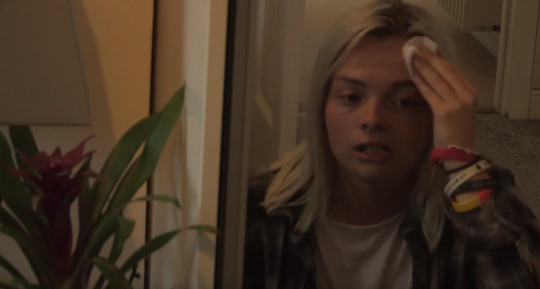

Kitchen Scene
This scene was filmed smoothly as all the cast and crew knew exactly what shots I needed and the intention behind the scene to build up tension for the audience and to show Cara being freaked out whilst alone to portray that she is wary of events unfolding around her in the neighborhood. When Abbie enters the kitchen behind Cara, I had intended this to come across as a shadow creeping up behind her in the window’s reflection, however due to the lighting and time of day this proved difficult to produce so instead the audience can see Abbie approaching, but she does so slowly and creepily as if she is transfixed and looks like she is about to attack Cara.

Lighting proved to be the main issue I had for the whole production. As a director I should have been more hands on with cinematography, especially as this is the role I would go for in the industry. If the film does not look nice, that primarily falls down to me, as the director, not informing the camera operator on how the shot needs to look. If we had watched and taken on board the advice given in this video below, we may not have struggled as much in the low-lit environments.
youtube
How to Film in Low Light | 6 Cinematic Tips - Aputure (24 Sep 2018)
0 notes